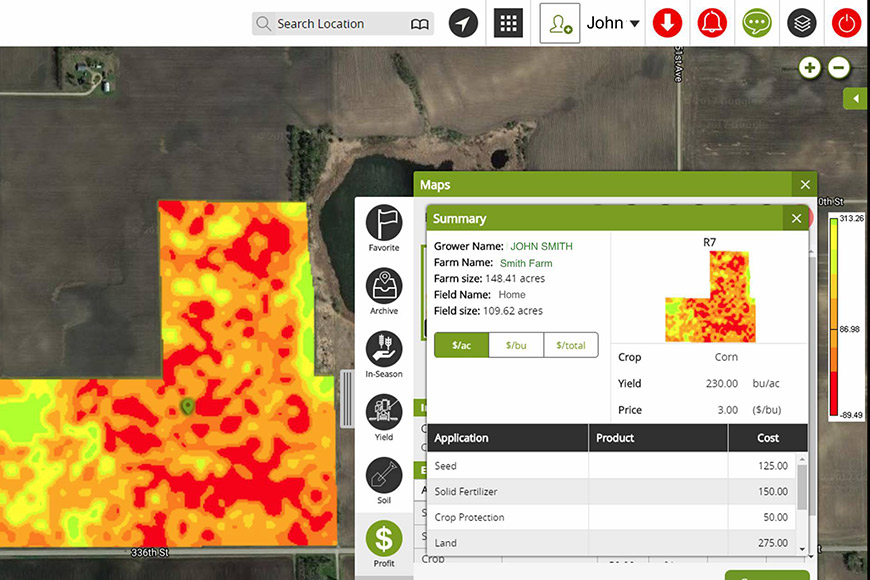7 Ways to Turn Data Into a Prescription

Effective in-season management of inputs like nutrients and crop protection products can help you promote crop health, foster sustainability, and achieve optimal ROI and yield potential at harvest.
The R7® Tool uses data from nearly 200 Answer Plot® locations to enable you and your trusted advisor to create effective prescriptions for input applications. More than 6 million data points are collected and analyzed each year by location, hybrid or variety, management strategy, and more. They are fed into the R7 Tool to reveal timely information that can help you unlock optimal yield and ROI potential. Here are some elements that can factor into creating tailored prescriptions for your fields.
1. Access yield potential maps.
Locate the most- and least-productive areas of your fields by using historical information found in the R7 Tool. Yield potential maps help you understand how various areas of your fields have performed over time. The R7 Tool also houses soil variability maps and elevation maps to help you create yield potential zones denoting where to concentrate management efforts.
2. View in-season imagery.
The R7 Field Monitoring Tool uses daily low-resolution imagery to help you and your advisor see which fields are performing well and pinpoint where problems lie. This gives you the opportunity to better direct your scouting efforts. If you need to address a particular area in a corn field, you can develop a prescription for proper management — perhaps with a nitrogen or micronutrient application, or a fungicide application. In a soybean field, in-season management of iron deficiency chlorosis might be in order.
3. Add in tissue test results.
Taking and testing tissue samples tells you which nutrients are adequate or deficient in your plants. Tissue-test results are automatically fed into the R7 Tool and the R7 Field Monitoring Tool for you and your advisor to review and remedy if necessary.
Test results are also fed into the R7 Field Forecasting Tool, a crop model that uses in-season calibrations to help ensure accurate and timely decision-making. The Field Forecasting Tool models nitrogen, potassium and water stresses within the crop at various growth stages. Then, it makes adjustments to the model based on any nutrient applications, rainfall or in-field observations. The tool also provides a yield prediction to help make input decisions.
4. Gauge response-to scores
Answer Plot data can inform you about which corn hybrids will have a higher response to an in-season fungicide or nitrogen application. For example, if you have planted a low response-to-nitrogen (RTN) hybrid that’s low on nitrogen, and you have another hybrid with a high RTN, you can create a nitrogen prescription for that hybrid that will better use that nutrient.
5. Share information
Your agronomist probably has more data available on your fields than you do, but you possess vital background history about your farm. The two of you should share that information. The more information your agronomist can give you, the better he or she can validate a recommendation. Or, the more information you can provide to your agronomist, the better he or she can shape it to fit your farm more precisely. Bottom line: The more information that’s available to make a prescription, the better.
6. Use available tech avenues
Your trusted advisor will play a big role in your ag technology efforts, but you can also access information on your own. For example, you can pull up in-season and archived imagery from the Field Monitoring Tool on your desktop, tablet or phone. Use these pathways to monitor field performance and work closely with your advisor to make the best decisions.
7. Strive for sustainability and ROI
All these factors allow you to target your input investments and crop inputs to those crops and areas that can use them the most and give you the most ROI potential. This also provides you with peace of mind because you know you are applying products to those areas that need them. ROI is important, but being sustainable and responsible is also a key factor in the long-term success of your operation.
For more information on using all the data at your disposal to create field prescriptions, talk with your trusted advisor.
The R7® Tool uses data from nearly 200 Answer Plot® locations to enable you and your trusted advisor to create effective prescriptions for input applications. More than 6 million data points are collected and analyzed each year by location, hybrid or variety, management strategy, and more. They are fed into the R7 Tool to reveal timely information that can help you unlock optimal yield and ROI potential. Here are some elements that can factor into creating tailored prescriptions for your fields.
1. Access yield potential maps.
Locate the most- and least-productive areas of your fields by using historical information found in the R7 Tool. Yield potential maps help you understand how various areas of your fields have performed over time. The R7 Tool also houses soil variability maps and elevation maps to help you create yield potential zones denoting where to concentrate management efforts.
2. View in-season imagery.
The R7 Field Monitoring Tool uses daily low-resolution imagery to help you and your advisor see which fields are performing well and pinpoint where problems lie. This gives you the opportunity to better direct your scouting efforts. If you need to address a particular area in a corn field, you can develop a prescription for proper management — perhaps with a nitrogen or micronutrient application, or a fungicide application. In a soybean field, in-season management of iron deficiency chlorosis might be in order.
3. Add in tissue test results.
Taking and testing tissue samples tells you which nutrients are adequate or deficient in your plants. Tissue-test results are automatically fed into the R7 Tool and the R7 Field Monitoring Tool for you and your advisor to review and remedy if necessary.
Test results are also fed into the R7 Field Forecasting Tool, a crop model that uses in-season calibrations to help ensure accurate and timely decision-making. The Field Forecasting Tool models nitrogen, potassium and water stresses within the crop at various growth stages. Then, it makes adjustments to the model based on any nutrient applications, rainfall or in-field observations. The tool also provides a yield prediction to help make input decisions.
4. Gauge response-to scores
Answer Plot data can inform you about which corn hybrids will have a higher response to an in-season fungicide or nitrogen application. For example, if you have planted a low response-to-nitrogen (RTN) hybrid that’s low on nitrogen, and you have another hybrid with a high RTN, you can create a nitrogen prescription for that hybrid that will better use that nutrient.
5. Share information
Your agronomist probably has more data available on your fields than you do, but you possess vital background history about your farm. The two of you should share that information. The more information your agronomist can give you, the better he or she can validate a recommendation. Or, the more information you can provide to your agronomist, the better he or she can shape it to fit your farm more precisely. Bottom line: The more information that’s available to make a prescription, the better.
6. Use available tech avenues
Your trusted advisor will play a big role in your ag technology efforts, but you can also access information on your own. For example, you can pull up in-season and archived imagery from the Field Monitoring Tool on your desktop, tablet or phone. Use these pathways to monitor field performance and work closely with your advisor to make the best decisions.
7. Strive for sustainability and ROI
All these factors allow you to target your input investments and crop inputs to those crops and areas that can use them the most and give you the most ROI potential. This also provides you with peace of mind because you know you are applying products to those areas that need them. ROI is important, but being sustainable and responsible is also a key factor in the long-term success of your operation.
For more information on using all the data at your disposal to create field prescriptions, talk with your trusted advisor.






